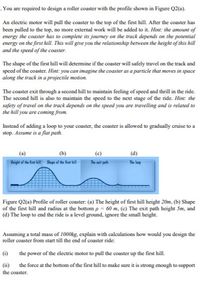
Structural Analysis
6th Edition
ISBN: 9781337630931
Author: KASSIMALI, Aslam.
Publisher: Cengage,
expand_more
expand_more
format_list_bulleted
Concept explainers
Question

Transcribed Image Text:. You are required to design a roller coaster with the profile shown in Figure Q2(a).
An electric motor will pull the coaster to the top of the first hill. After the coaster has
been pulled to the top, no more external work will be added to it. Hint: the amount of
energy the coaster has to complete its journey on the track depends on the potential
energy on the first hill This will give you the relationship berween the height of this hill
and the speed of the coaster.
The shape of the first hill will detemine if the coaster will safely travel on the track and
speed of the coaster. Hint: you can imagine the coaster as a particle that moves in space
along the track in a projectile motion.
The coaster exit through a second hill to maintain feeling of speed and thrill in the ride.
The second hill is also to maintain the speed to the next stage of the ride. Hint: the
safety of travel on the track depends on the speed you are travelling and is related to
the hill you are coming from.
Instead of adding a loop to your coaster, the coaster is allowed to gradually cruise to a
stop. Assume is a flat path.
(c)
(d)
Height of the fint kill Shupa af the fint kil-
The it path
The loop
Figure Q2(a) Profile of roller coaster: (a) The height of first hill height 20m, (b) Shape
of the first hill and radius at the bottomp = 60 m, (c) The exit path height 5m, and
(d) The loop to end the ride is a level ground, ignore the small height.
Assuming a total mass of 1000kg, explain with calculations how would you design the
roller coaster from start till the end of coaster ride:
O the power of the electric motor to pull the coaster up the first hill.
the force at the bottom of the first hill to make sure it is strong enough to support
(i)
the coaster.
Expert Solution
This question has been solved!
Explore an expertly crafted, step-by-step solution for a thorough understanding of key concepts.
This is a popular solution
Trending nowThis is a popular solution!
Step by stepSolved in 2 steps with 2 images

Knowledge Booster
Learn more about
Need a deep-dive on the concept behind this application? Look no further. Learn more about this topic, civil-engineering and related others by exploring similar questions and additional content below.Similar questions
- A rectangular tank 7m long by 2.4m deep and 2.65m wide, contains 1.2m of water.If the linear acceleration horizontal in the direction of the tank's length is 2.75m/s²a) Compute the total force due to the water acting on each end of the tankb) Show that the difference between these forces equals the unbalanced force necessary to accelerate the liquid massc) If the tank is filled with water and accelerate in the direction of its length at the rate 1.72m s³, how many litres of water are spilledd) What is the maximum acceleration should be to keep no water will spill outarrow_forward5.5arrow_forwardQ2.characteristics of a small underwater craft are studied under dynamic similarity conditions in a varable density wind tunnel on a model scale of 1:12. What prototype speed and power are indicated by model values of 100m/sec of velocity and 30N of drag force? The model is operated at 8atm pressure [Take Pair at atmospheric pressure-0.95Kg/m³, Pwater-998Kg/m³. Hwater 1.0*103 pa.sec and Hair-2.17*105 pa.sec].arrow_forward
arrow_back_ios
arrow_forward_ios
Recommended textbooks for you

 Structural Analysis (10th Edition)Civil EngineeringISBN:9780134610672Author:Russell C. HibbelerPublisher:PEARSON
Structural Analysis (10th Edition)Civil EngineeringISBN:9780134610672Author:Russell C. HibbelerPublisher:PEARSON Principles of Foundation Engineering (MindTap Cou...Civil EngineeringISBN:9781337705028Author:Braja M. Das, Nagaratnam SivakuganPublisher:Cengage Learning
Principles of Foundation Engineering (MindTap Cou...Civil EngineeringISBN:9781337705028Author:Braja M. Das, Nagaratnam SivakuganPublisher:Cengage Learning Fundamentals of Structural AnalysisCivil EngineeringISBN:9780073398006Author:Kenneth M. Leet Emeritus, Chia-Ming Uang, Joel LanningPublisher:McGraw-Hill Education
Fundamentals of Structural AnalysisCivil EngineeringISBN:9780073398006Author:Kenneth M. Leet Emeritus, Chia-Ming Uang, Joel LanningPublisher:McGraw-Hill Education
 Traffic and Highway EngineeringCivil EngineeringISBN:9781305156241Author:Garber, Nicholas J.Publisher:Cengage Learning
Traffic and Highway EngineeringCivil EngineeringISBN:9781305156241Author:Garber, Nicholas J.Publisher:Cengage Learning


Structural Analysis (10th Edition)
Civil Engineering
ISBN:9780134610672
Author:Russell C. Hibbeler
Publisher:PEARSON

Principles of Foundation Engineering (MindTap Cou...
Civil Engineering
ISBN:9781337705028
Author:Braja M. Das, Nagaratnam Sivakugan
Publisher:Cengage Learning

Fundamentals of Structural Analysis
Civil Engineering
ISBN:9780073398006
Author:Kenneth M. Leet Emeritus, Chia-Ming Uang, Joel Lanning
Publisher:McGraw-Hill Education


Traffic and Highway Engineering
Civil Engineering
ISBN:9781305156241
Author:Garber, Nicholas J.
Publisher:Cengage Learning